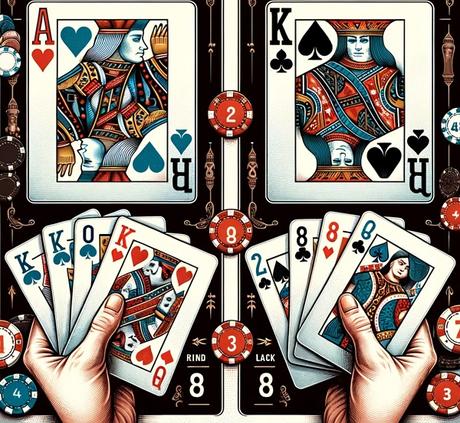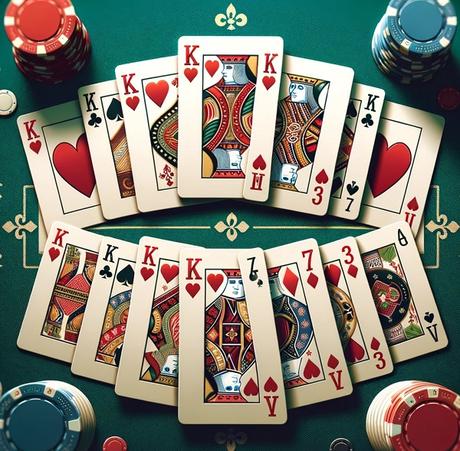
Three-card poker, a game that seamlessly blends the thrill of traditional poker with the ease and speed of classic table games, is a popular choice among casino enthusiasts. Unlike its standard counterpart, Three-Card Poker is a straightforward game that is easy to grasp, making it equally accessible to both beginners and seasoned players. A key to mastering this game is understanding the hands that are most likely to lead to victory and those that are best left folded. In this article, we’ll delve into the ten best and worst hands in Three-Card Poker, equipping you with the knowledge to make astute betting decisions and elevate your gameplay. Whether you’re aiming to maximise your winnings or minimise your losses, this understanding can significantly influence your success at the table.
Section 1: Understanding Three-Card Poker Hand Rankings
Before diving into the best and worst hands, it’s important to understand the hand rankings in Three-Card Poker. The hands are ranked from highest to lowest as follows:
- Straight Flush: Three consecutive cards of the same suit.
- Three of a Kind: Three cards of the same rank.
- Straight: Three consecutive cards of different suits.
- Flush: Three cards of the same suit.
- Pair: Two cards of the same rank.
- High Card: The highest card in your hand when no other hand is made
Section 2: The Best Hands in Three-Card Poker
Introduction to Best Hands and Their Significance
The best hands in Three-Card Poker provide the highest probability of winning and can guide your betting decisions. Understanding these hands is crucial for maximising your winnings.
- Straight Flush
- Description: This is the highest-ranking hand in Three-Card Poker, consisting of three consecutive cards of the same suit.
- Odds: The odds of being dealt a straight flush are approximately 0.22%.
- Example: 5-6-7 of hearts.
- Three-of-a-Kind
- Description: This hand consists of three cards of the same rank.
- Odds: The odds of being dealt three of a kind are around 0.24%.
- Example: 7-7-7.
- Straight
- Description: Three consecutive cards of different suits.
- Odds: The odds of being dealt a straight are about 3.26%.
- Example: 4-5-6 of mixed suits.
- Flush
- Description: Three cards of the same suit, but not in sequence.
- Odds: The odds of being dealt a flush are approximately 4.96%.
- Example: 2-6-10 of diamonds.
- Pair
- Description: Two cards of the same rank.
- Odds: The odds of being dealt a pair are around 16.94%.
- Example: Q-Q-7.
Section 3: The Worst Hands in Three-Card Poker
Introduction to Worst Hands and Their Significance
 Ten of The Best and Worst Hands in Three-Card Poker
Ten of The Best and Worst Hands in Three-Card Poker
Recognising the worst hands in Three-Card Poker, which have the lowest probability of winning, is essential for making decisions about folding. Being aware of these hands can help you avoid unnecessary losses.
- High Card with No Suit Connection
- Description: Three high cards that do not form any other hand or suit connection.
- Odds: This is a common outcome; the odds are high but vary depending on the specific cards.
- Example: K-8-3 of different suits.
- Three Low Cards (2, 3, 4)
- Description: Three low-ranking cards that are not connected.
- Odds: The odds are high as most hands will not be low and unconnected.
- Example: 2-3-4 of different suits.
- High Card with One High Face Card
- Description: A hand with one high face card and two low cards that don’t connect.
- Odds: Common; odds vary based on the specific cards.
- Example: K-4-7 of different suits.
- Non-Connecting Low Cards
- Description: Low cards that don’t form any other hand.
- Odds: High odds as many hands will not form stronger combinations.
- Example: 2-5-8 of different suits.
- Mixed Low and Mid Cards
- Description: A mix of low and mid-ranking cards that don’t form a pair, straight, or flush.
- Odds: Common occurrence; odds vary based on the specific cards.
- Example: 3-6-9 of different suits.
Section 4: Strategies for Playing the Best and Worst Hands
It’s important to employ effective strategies for the best and worst hands to maximise your winnings and minimise your losses.
- Maximising Wins with the Best Hands:
- Always bet confidently when holding a straight flush, three-of-a-kind, or a straight
- Consider raising your bet when you have a flush or pair, depending on the dealer’s upcard.
- Minimising Losses with the Worst Hands:
- Fold early when you have a high card with no suit connection or non-connecting low cards.
- Be cautious with mixed low and mid cards, as these hands rarely win.
- General Tips for Three-Card Poker Strategy:
- Always pay attention to the dealer’s upcard.
- Practice good bankroll management to ensure you can stay in the game longer.
- Understand the house rules and payouts, as they can vary between casinos.
Conclusion
Three-card poker is a game of both skill and chance. Understanding the best and worst hands can improve your decision-making and increase your chances of winning. Whether you’re a novice or an experienced player, keeping these tips in mind can help you play more effectively and enjoy the game to its fullest.
If you found this article helpful, be sure to subscribe for more poker tips and strategies. Please share this article with your friends who enjoy Three-Card Poker and let us know your thoughts and experiences in the comments below.

